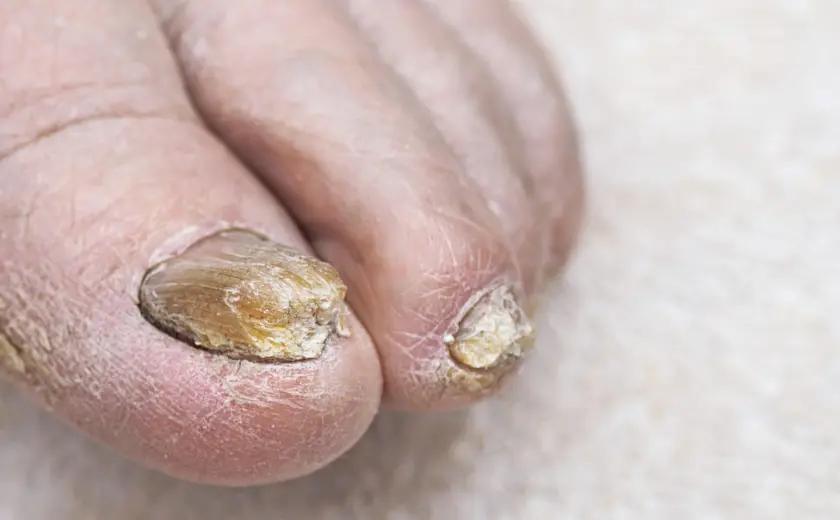How Diabetes Increases the Risk of Fungal Nail Infections
Fungal nail infections are common, but for individuals living with diabetes, they are more than just a cosmetic concern. Diabetes affects blood circulation, nerve health, and the body’s ability to fight infections, which makes the feet especially vulnerable. A simple foot nail fungal infection can develop into something more serious if ignored. Understanding fungal nail infection causes, identifying early symptoms, and knowing when to seek timely care can protect long-term foot health.
At Surat Diabetic Foot and Ulcer Clinic, we focus on comprehensive foot care that helps diabetic patients stay ahead of such complications with the right guidance and treatment.
What Is a Fungal Nail Infection?
A fungal nail infection, medically known as onychomycosis, occurs when fungi invade the nail bed or nail plate. It often begins as a small discolouration and gradually spreads deeper into the nail, leading to thickening, brittleness, and discomfort. The condition is common in toenails because feet are enclosed for long hours and are more exposed to moisture.
There are several types of toenail fungus, including dermatophytes, yeast infections, and mould-related infections. Each behaves differently, but all require prompt and careful management, especially for diabetic individuals.
How Diabetes Affects the Body
Diabetes brings a set of systemic changes that influence how the body responds to infections. High blood sugar affects the immune system, making it harder for the body to fight off fungal growth. It also reduces the efficiency of white blood cells, which are essential for healing.
Another major effect is neuropathy, a condition where nerve function in the feet becomes impaired. With reduced sensation, small injuries or discomfort may go unnoticed, giving fungal infections more time to worsen.
Why Diabetics Are at Higher Risk
A combination of factors makes fungal nail infections more common in people with diabetes:
- Reduced blood flow slows down the healing process and weakens the defence against fungi.
- Higher blood sugar levels create an environment where fungi thrive more easily.
- Foot deformities or thickened skin can trap moisture and increase fungal exposure.
- Weakened immunity limits the body’s ability to control fungal growth naturally.
This is why diabetic patients often require the best toenail fungus treatment planned under medical supervision, rather than home remedies or over-the-counter options.
Common Signs and Symptoms
A fungal nail infection develops gradually, and early symptoms may be subtle. Look out for:
- White, yellow, or brown discolouration of the nail
- Thickened or brittle nails
- Nails that crumble or chip easily
- A distorted nail shape
- Pain, tenderness, or pressure while walking
- A foul smell coming from the nail
- Separation of the nail from the nail bed
Recognising fungal nail infection symptoms early allows timely intervention, preventing deeper damage and reducing the risk of complications.
Prevention Tips
Keeping your feet protected is essential if you have diabetes. Here are simple preventive steps:
- Keep feet clean and completely dry after washing.
- Trim nails straight across and avoid cutting too close to the skin.
- Wear moisture-wicking socks and breathable footwear.
- Avoid walking barefoot in public areas such as pools and changing rooms.
- Choose properly fitted shoes to avoid friction and pressure.
- Manage blood sugar levels consistently.
- Inspect your feet daily for small changes, cuts, or nail irregularities.
- Seek early guidance from a toenail fungus doctor if you notice any abnormality.
These habits significantly reduce the chances of developing infections and support better long-term foot health.
When to See a Doctor
If you have diabetes, do not wait for a fungal nail infection to worsen. You should consult a specialist when:
- You notice persistent nail discolouration or thickening
- The infection is spreading to other nails
- Walking becomes painful due to pressure on the nail
- You have additional symptoms like redness or swelling around the nail
- You have tried home care, but see no improvement
A specialist can diagnose the exact type of fungal infection and offer the most effective fungal nail infection treatment based on your condition. Early medical care prevents complications such as deeper tissue infections, ulcer formation, or difficulty walking.
Conclusion
Fungal nail infections may seem minor at first, but for someone living with diabetes, they deserve careful attention. Understanding fungal nail infection causes, spotting the early signs, and seeking the right treatment can protect the feet from long-term complications. With regular foot checks and timely intervention, it is possible to maintain healthy nails and strong foot confidence.
Surat Diabetic Foot and Ulcer Clinic specialises in providing advanced and safe treatment options for fungal nail infections. If you are noticing any unusual toenail changes, our team is here to help you find the best solution for your foot health.
FAQs
What are the signs of a fungal nail infection?
Discolouration, thickening, brittleness, foul smell, pain while walking, and nail shape changes are common signs.
Can high blood sugar cause fungal nail infections?
High blood sugar weakens immunity and creates a favourable environment for fungal growth. This increases the risk of nail infections.
How can I prevent fungal nail infections if I have diabetes?
Maintain good foot hygiene, keep nails trimmed, wear breathable footwear, manage blood sugar levels, and check your feet daily.
What should I do if I notice changes in my toenails?
Consult a toenail fungus doctor for proper diagnosis and early treatment. Timely medical care helps prevent complications, especially if you have diabetes.




